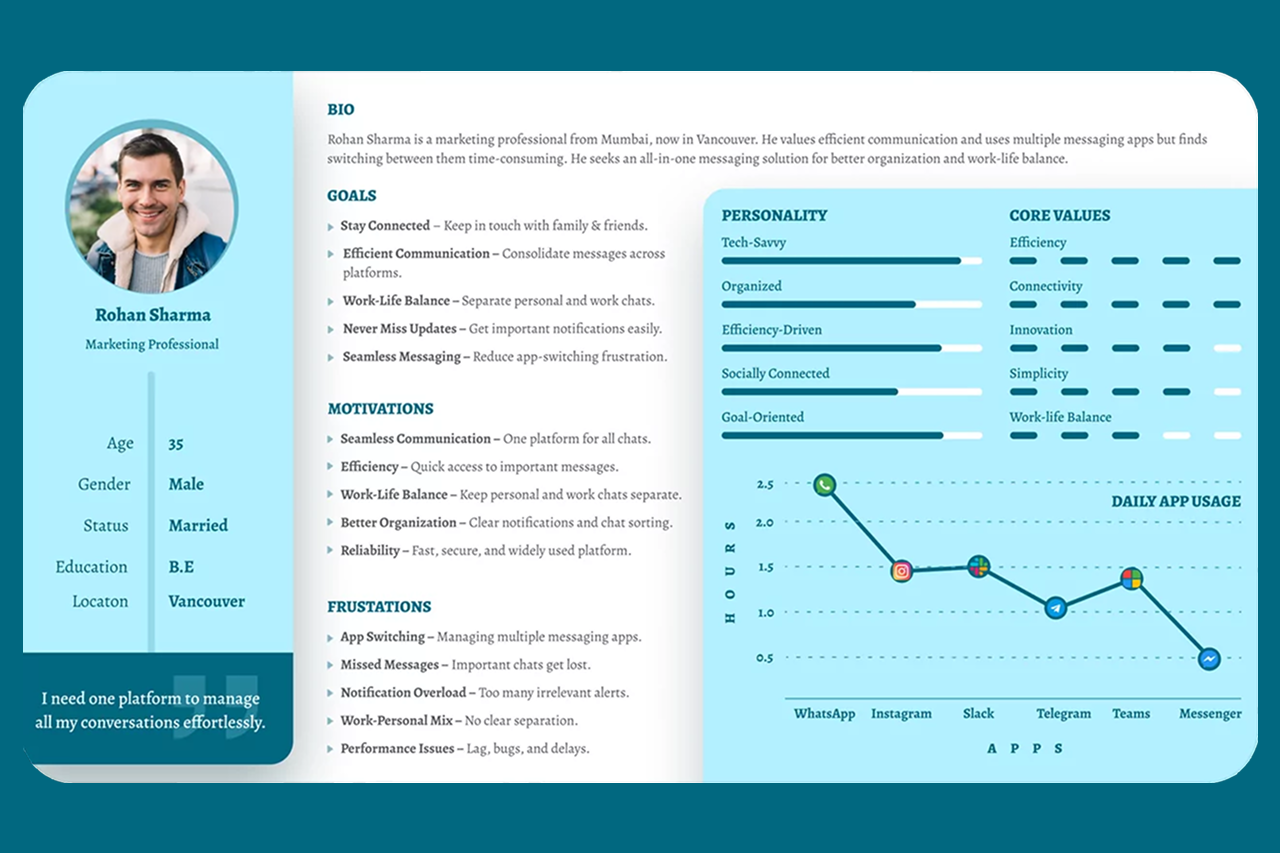From Theory to Clickable: How UX Research Turned a WMDD Student to Human-Centered Design

The Start of the Journey to a Good Product
My first semester in the Langara WMDD program started with an ambitious project: an app that lets international students and workers synchronize multiple messaging and social media apps in one hub allowing them to easily manage all the communications they may have.
When a design starts just from an idea, we don’t necessarily know if at the end of the project that idea can generate a real impact in the market or even if it fits a certain market need. Indeed, the lessons I learned helped me realize that research is the best way to start a solid project.
Why Good Research is the Starting Point for Product Design
Design without research generally doesn’t have a purpose. Rather, the valuable insights derived from research allow companies to:
- Reduce costs
- Increase satisfaction
- Ensure accessibility
Research allows you to add context and insight to the design process. The most common problems of a design process without research are:
- Assumed problems
- More time spent fixing than innovating
- Delivering half-baked features
Research Methodology and Findings for My Project
The methods we used for the project let us:
- Identify pain points
- Uncover motivations
- Understand user context
- Understand user behaviour

This research allowed us to identify the following pain points and let us drive our design in a real user-centered prototype:
“I open too many apps each morning.”
- We made a unified view for all of the chats.
Language switching amplifies cognitive load.
- We added a real-time translation feature.
“I forget plans or I can’t find them between many chats and chat threads.”
- We introduced a reminder feature for the user.
“I want to keep things categorized.”
- We let the user categorize the chats, channels and group them based on purpose, like: family, friends, work, etc.
Sometimes the mobile internet connection is not stable, so users can not send messages via social media apps.
- We allowed the user to overcome this situation by changing the service to SMS
“When I meet a new friend, some of us need to install a new messaging app, because we don’t share the same messaging or social media app.”
- Because our app allows users from different services or platforms to communicate, this problem was reduced.
Why is this important?
Listen First, Sketch Second
The “aha” moment comes before any prototype. This is important because the designers won’t have to reassess prior assumptions or repeatedly revise an already developed prototype—in other words, knowing the insights from the beginning lets the team frame a real value proposition.
Small Samples, Big Direction
Sometimes you don’t need to have a big sample to identify a pattern: interviewing small quantities of users let designers identify more than 70% or 80% of the recurrent pain points. And quality outweighs quantity in an agile working environment.
Metrics Beat Opinions
When prototyping, the most common error is to consider that our assumptions and experience are good criteria with which to conceive our product. However, usability metrics show that most of the time our assumptions do not match user beliefs or don’t inform user behavior.
Research is a Continuous Loop
The research process must be always active: as trends change, user behavior changes as well, as new potential solutions to user needs enter the market. This is another reason why research is always important in order to prevent obsolescence of a product, whether it’s a service, app or physical product.
Practical Takeaways for Designers
- Start with a single and measurable question guided by the methods you choose.
- Mix methods to validate or contrast the findings in your work. Sometimes just one method doesn’t give us a whole view of the problem or the context. Quantitative data aims to determine where the problem is, qualitative data reveals why the problem occurs.
- Prototype just enough to test. It’s important to consider that low-fidelity flows or prototypes save hours, and even many sprints of work can still give us navigation or prototyping issues.
- Share findings visually. It is important that all of the information gathered in our research be shared with different stakeholders in a way that they can understand and empathize with. This helps motivate them to work in the same direction towards solutions.
Research is the Best Shortcut:
In the rush of deadlines, skipping the research process can sound like a practical or good tactic. But the fastest path for the product teams is first to take time to understand their users and have not only a clear but a secure idea of what they need to do and what they can prioritize.
Whether you’re a beginner, student or a senior professional, keep the questions flowing, the methods mixed and always the user at the center if you are trying to achieve good results.
Pixels are easy to do and change, insights are priceless.




